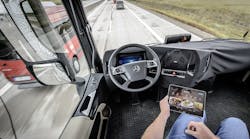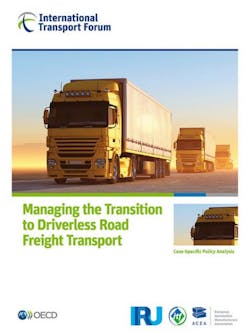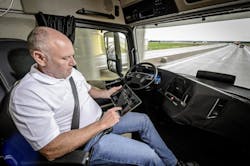A new joint report issued by four European transport groups estimates that between two million to 4.4 million truck driving jobs in the U.S. and Europe could become “redundant” and thus be eliminated in just 13 years if efforts aimed at widely deploying self-driving commercial vehicles are successful.
This new study – entitled Managing the Transition to Driverless Road Freight Transport and prepared jointly by the European Automobile Manufacturers’ Association (ACEA), the International Transport Workers’ Federation (ITWF), the International Road Transport Union (IRU), and the International Transport Forum (ITF) – noted that driverless trucks could be a regular presence on many roads within the next decade, as they are already operating in “controlled environments” such as ports or mines, awhile undergoing testing on public roads in both the U.S. and European Union.
“Manufacturers are investing heavily into truck-automation technology, while many governments are actively reviewing their regulations to understand what changes would be required to allow self-driving vehicles on public roads,” noted José Viegas, the ITF’s Secretary-General, in a statement.
He pointed out that automated trucks would enable cost savings, lower emissions and safer roads, while also addressing what Viegas called the “emerging shortage” of professional drivers faced by the trucking industry, particularly in Europe.The cost savings derived from a switch to driverless trucks are of keen interest, too, as labor currently accounts for an estimated 35% to 45% of operating costs of road freight in Europe, he noted.
And that’s before the impact of the driver shortage is calculated. Without driverless trucks, around 6.4 million truck drivers are projected to be needed across the U.S. and Europe by 2030, according to the report – while fewer than 5.6 million are expected to be willing to work under what the study described as “current trucking conditions.”
The report went on to note that majority of those currently working as truck drivers “are in the later stages of their careers,” with few women and younger men choosing trucking as a profession.
“The adoption of driverless trucks is likely to reduce demand for drivers at a faster rate than a supply shortage would emerge,” the study concluded.
Along similar lines, James Arbib, co-founder of independent research group RethinkX, is working on a similar trucking study that examines the impact of not just self-driving technology but a changeover to electric propulsion as well – mirroring the group’s recent report for light vehicles entitled Rethinking Transportation 2020-2030: The Disruption of Transportation and the Collapse of the ICE Vehicle and Oil Industries.
Arbib told Fleet Owner that the “move to autonomy” in trucking will address one of the three “big costs” of commercial vehicle operation: driver wages, fuel, and maintenance.
While he stressed human drivers will still be required to operate large trucks, especially in dense urban areas for “last mile” deliveries, automation will allow for far higher truck utilization rates and for use at times when highway traffic is minimal, which will improve safety.
Yet he echoed the conclusions of the ITF-led driverless freight transport report, stressing that automated trucks “will hit like a train” and result in millions of job losses if the trucking industry does not prepare itself.
Indeed, the ITF-led driverless truck report emphasized that solving the shortage via the broad adoption of autonomous technology will lead to deep cuts in available truck driving positions in the U.S. and Europe alike.
All told, out of the 6.4 million truck driver jobs expected to be available by 2030, the report found that between 3.4 million and 4.4 million would “become redundant” if driverless trucks are deployed quickly.
Even accounting for prospective truck drivers being “progressively dissuaded” by the advent of self-driving commercial vehicles, over two million drivers across the U.S. and Europe could be “directly displaced” by 2030 in some of the scenarios examined for this joint study.
“While truck drivers are typically flexible, self-reliant and able to concentrate for long periods, their relatively low education level and potential automation in other sectors puts them at a high risk of extended periods of unemployment,” the report noted.
On top of that, financial support for those displaced workers in developed economies may prove to be inadequate given the potential speed and scale of job losses, the study emphasized.
“We must avoid excessive hardship for truck drivers and ensure the gains from the technology are fairly shared across society [as] self-driving trucks threaten to disrupt the careers and lives of millions of professional truck drivers,” added Steve Cotton, the ITFW’s General Secretary, in a statement. “Automation in trucking demands a managed and just transition.”
To that end, the four groups involved in compiling this report offered four major recommendations to “smooth” the transition to driverless trucks in order to avoid “potential social disruption” from job losses:
- Governments, industry and researchers should continue to advance self-driving truck tests on public roads in designated corridors and areas so no commitment is made to an individual company, standard or technology too early in the development process. “This will help ensure societal benefits from automated road freight transport will be maximized,” according to the study.
- The “harmonization of rules” across countries to create common vehicle standards and operational rules would allow for smoother cross-border movements of autonomous trucks and should be put in place at least at a continental level, but preferably at the global level.
- Governments should establish a temporary transition advisory board that includes representatives from labor unions, road freight businesses, vehicle manufacturers and government to help determine the “right policy mix” to ensure that the costs, benefits, and risks from automated road haulage are “fairly distributed.”
- Governments should consider establishing a “temporary permit system” to manage the speed of driverless technology adoption while supporting a “just transition” for displaced drivers. Such a permit system would offer revenue to support displaced drivers, with funds for “transition assistance” generated by the main beneficiaries of the operation of driverless trucks. “Careful design of the permit system would ensure that permits are used to manage the labor transition fairly and not as a proxy to limit the free movement of goods,” the report noted.





